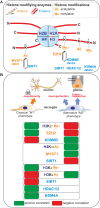Epigenetics Control Microglia Plasticity
- PMID: 30123114
- PMCID: PMC6085560
- DOI: 10.3389/fncel.2018.00243
Epigenetics Control Microglia Plasticity
Abstract
Microglia, resident immune cells of the central nervous system, fulfill multiple functions in the brain throughout life. These microglial functions range from participation in innate and adaptive immune responses, involvement in the development of the brain and its homeostasis maintenance, to contribution to degenerative, traumatic, and proliferative diseases; and take place in the developing, the aging, the healthy, or the diseased brain. Thus, an impressive level of cellular plasticity, appears as a requirement for the pleiotropic biological functions of microglia. Epigenetic changes, including histone modifications or DNA methylation as well as microRNA expression, are important modifiers of gene expression, and have been involved in cell phenotype regulation and reprogramming and are therefore part of the mechanisms regulating cellular plasticity. Here, we review and discuss the epigenetic mechanisms, which are emerging as contributors to this microglial cellular plasticity and thereby can constitute interesting targets to modulate microglia associated brain diseases, including developmental diseases, neurodegenerative diseases as well as cancer.
Keywords: DNA methylation; epigenetics; histone post-translational modification; microglia; non-coding RNAs.
Figures


Similar articles
-
Microglial innate memory and epigenetic reprogramming in neurological disorders.Prog Neurobiol. 2021 May;200:101971. doi: 10.1016/j.pneurobio.2020.101971. Epub 2020 Dec 9. Prog Neurobiol. 2021. PMID: 33309803 Review.
-
Epigenetic Regulations of Microglia/Macrophage Polarization in Ischemic Stroke.Front Mol Neurosci. 2021 Oct 11;14:697416. doi: 10.3389/fnmol.2021.697416. eCollection 2021. Front Mol Neurosci. 2021. PMID: 34707480 Free PMC article. Review.
-
Microglial priming and enhanced reactivity to secondary insult in aging, and traumatic CNS injury, and neurodegenerative disease.Neuropharmacology. 2015 Sep;96(Pt A):29-41. doi: 10.1016/j.neuropharm.2014.10.028. Epub 2014 Nov 13. Neuropharmacology. 2015. PMID: 25445485 Free PMC article. Review.
-
The heterogeneity of microglial activation and its epigenetic and non-coding RNA regulations in the immunopathogenesis of neurodegenerative diseases.Cell Mol Life Sci. 2022 Sep 6;79(10):511. doi: 10.1007/s00018-022-04536-3. Cell Mol Life Sci. 2022. PMID: 36066650 Free PMC article. Review.
-
Epigenetics of Peripheral B-Cell Differentiation and the Antibody Response.Front Immunol. 2015 Dec 14;6:631. doi: 10.3389/fimmu.2015.00631. eCollection 2015. Front Immunol. 2015. PMID: 26697022 Free PMC article. Review.
Cited by
-
Effects of Suberoylanilide Hydroxamic Acid (SAHA) on the Inflammatory Response in Lipopolysaccharide-Induced N9 Microglial Cells.Cureus. 2022 Dec 12;14(12):e32428. doi: 10.7759/cureus.32428. eCollection 2022 Dec. Cureus. 2022. PMID: 36644097 Free PMC article.
-
MicroRNA-155 Promotes Heat Stress-Induced Inflammation via Targeting Liver X Receptor α in Microglia.Front Cell Neurosci. 2019 Feb 4;13:12. doi: 10.3389/fncel.2019.00012. eCollection 2019. Front Cell Neurosci. 2019. PMID: 30778287 Free PMC article.
-
Neuroimmune Interactions in Fetal Alcohol Spectrum Disorders: Potential Therapeutic Targets and Intervention Strategies.Cells. 2023 Sep 21;12(18):2323. doi: 10.3390/cells12182323. Cells. 2023. PMID: 37759545 Free PMC article. Review.
-
Spatial Transcriptomic Analysis Reveals HDAC Inhibition Modulates Microglial Dynamics to Protect Against Ischemic Stroke in Mice.Glia. 2025 Sep;73(9):1817-1840. doi: 10.1002/glia.70035. Epub 2025 May 26. Glia. 2025. PMID: 40415727 Free PMC article.
-
Differential DNA Methylation Is Associated With Hippocampal Abnormalities in Pediatric Posttraumatic Stress Disorder.Biol Psychiatry Cogn Neurosci Neuroimaging. 2021 Nov;6(11):1063-1070. doi: 10.1016/j.bpsc.2021.04.016. Epub 2021 May 5. Biol Psychiatry Cogn Neurosci Neuroimaging. 2021. PMID: 33964519 Free PMC article.
References
-
- Ben-Yehuda H., Matcovitch-Natan O., SpinradI A., Amit I., Schwartz M. (2017). Maternal immune activation alters microglia proliferation in the developing brain. Brain Behav. Immun. 66:e3 10.1016/j.bbi.2017.07.026 - DOI
Publication types
LinkOut - more resources
Full Text Sources
Other Literature Sources

